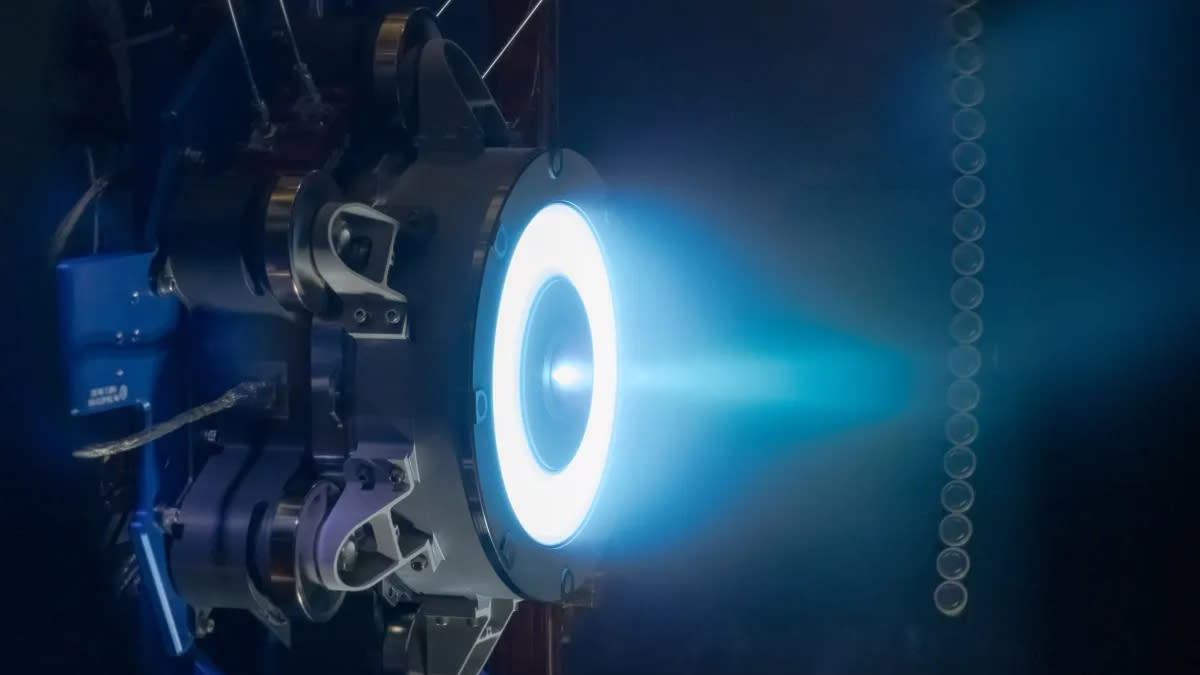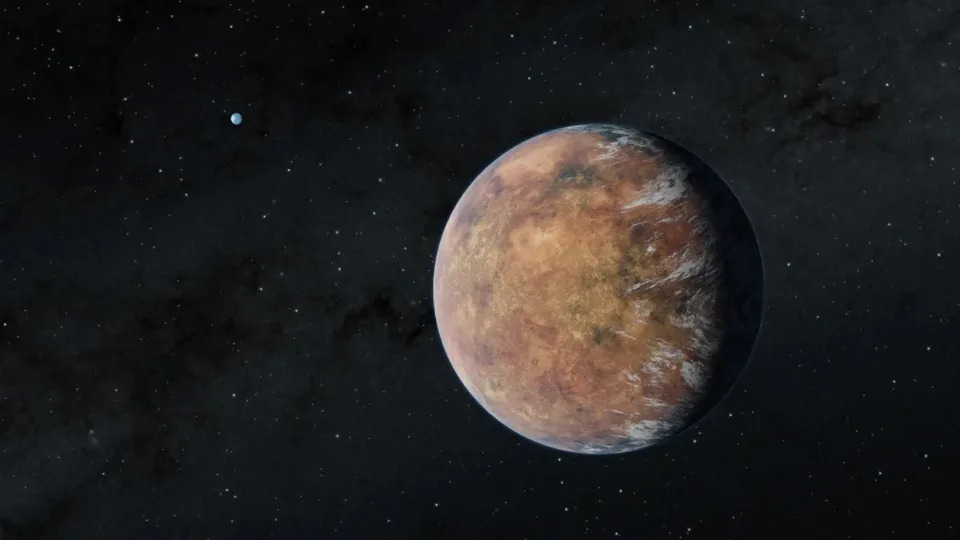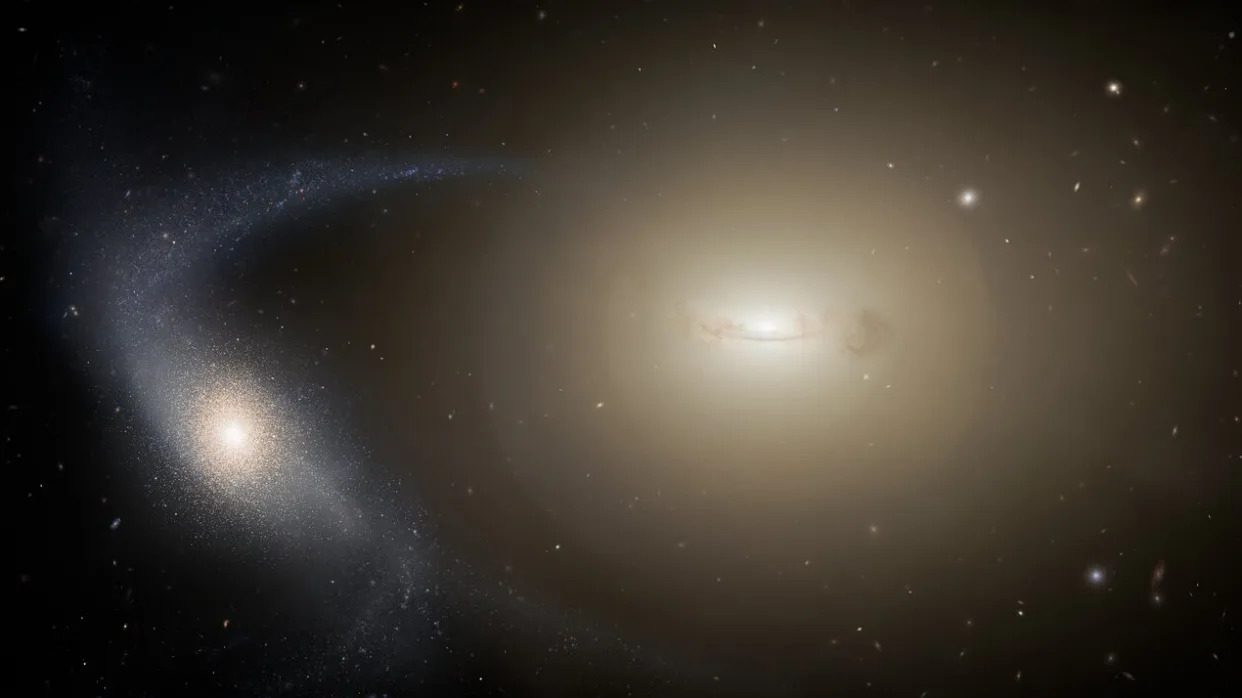Paul Sutter
Fri, November 10, 2023

A composite image showing the distribution of dark matter, galaxies, and hot gas in the core of the merging galaxy cluster Abell 52. The blue areas show regions with the most mass; dark matter makes up most of this mass.
The universe may have produced dark matter in the first few minutes of the Big Bang, according to new research. Those particles then got trapped into ultradense pockets. Some of those pockets splintered off to become black holes, which then dissolved into a shower of multiple dark matter particle "species," creating a "dark matter periodic table" of invisible elements, the study authors suggest.
Physicists still struggle to explain dark matter — the mysterious, invisible form of matter that makes up the vast majority of the universe's mass. While cosmologists and astronomers have identified circumstantial evidence for the existence of dark matter, from the rotation rates of stars within galaxies to the largest structures visible in the cosmos, they have not identified exactly what the dark matter is.
Previous work assumed that dark matter was simple: a single kind of extremely lightweight particle, flooding the universe, that hardly ever interacted with normal matter. But intense searches for new such particles have come up empty. That led cosmologists to wonder if the dark matter particles might be much rarer, but also much heavier. However, theoretical physicists have struggled to find models that would seed the early universe with the right number of such heavy particles.
In the new study, published in October in the preprint database arXiv, a team of cosmologists found a way to generate massive dark matter particles soon after the Big Bang. The trick was to sprinkle in black holes.
The paper noted that the early universe underwent severe phase transitions as the forces of nature split off from each other, going from a single unified force into the four fundamental forces of today. At each transition, the underlying physics changed. This isn't as wild as it sounds, as scientists can reproduce the last of these transitions in particle accelerators: At high enough energies, recreating the first few seconds of the Big Bang, we can observe the electromagnetic and weak nuclear forces merging into one.
The researchers found that ultraheavy dark matter could get trapped during one of these early-universe phase transitions. If the transition was messy, it would trigger the formation of bubbles, where some pockets of the universe had transitioned to the new physics while the rest had not yet made the change (like water boiling, with the gas phase of water trapped in bubbles surrounded by liquid).
In their model, the earliest dark matter was light but dark matter from later periods was heavy. In this scenario, dark matter gets trapped inside the bubbles, where the densities skyrocket to the point where all the dark matter collapses and forms black holes. Those black holes soon evaporate via Hawking radiation — in which radiation slowly "leaks" out of black holes in the form of thermal energy — well before the appearance of normal matter.
But as the black holes evaporate, dark matter makes a comeback, as the black holes spit out new dark matter particles before they die, the team's model showed. This clever mechanism limits the total amount of massive dark matter in the universe, because only so much can escape the black holes before they evaporate completely.
This evaporation process also generates a slew of dark matter particle species. While all of the dark matter particles share many characteristics (such as likely near-total invisibility), they would differ in their masses, speeds, and ways of interacting with normal matter. In this model, dark matter is a vast collection of different kinds of particles, much like normal matter is composed of the entire periodic table of the elements.
RELATED STORIES
—Our entire galaxy is warping, and a gigantic blob of dark matter could be to blame
—'Ghost' particles from the sun could lead us straight to an invisible trove of dark matter
—1st images from the Euclid 'dark universe' telescope are here — and they're jaw-dropping
Experimental evidence for this idea is still a long ways away, as it is right now a deeply hypothetical concept. Direct detection of one or more dark matter particle species would certainly bolster the idea. And astronomers are currently developing ways to observe gravitational waves from the big bang, which would give us direct observational access to this critical epoch in the history of the universe.
There could be all sorts of new interactions among these dark matter species, leading to a complex web of physics acting invisibly throughout the universe.
Powerful new thrusters for NASA's moon-orbiting Gateway space station get a test (photo)
Andrew Jones
Thu, November 9, 2023

A solar electric propulsion thruster emits the blue hue of Xenon gas during testing. Vibrant blue light emanates in a circular shape from the dark grey thruster, which is mounted inside a vacuum chamber. The blue light then narrows into a plume as it moves farther away from the thruster, illuminating the otherwise darkened chamber.
NASA and Aerojet Rocketdyne are taking a big step in testing a new ion propulsion engine that will help power lunar exploration.
The Advanced Electric Propulsion System (AEPS) has been undergoing qualification testing at NASA's Glenn Research Center in Cleveland, according to a statement from the agency.
AEPS is a Hall effect thruster, which accelerates ions to generate thrust. The AEPS uses electricity generated by solar arrays to create a steady stream of ionized xenon gas, producing low but highly efficient thrust.
Related: NASA's Gateway moon-orbiting space station explained in pictures
The 12-kilowatt Hall thruster is the most powerful electric propulsion thruster in production, according to NASA, being over two times more powerful than the current state-of-the-art in-space electric propulsion. The agency says the new thruster will be critical to future science and exploration missions at the moon and beyond.
"AEPS is truly a next-generation technology," Clayton Kachele, the AEPS project manager at NASA's Glenn Research Center in Cleveland, said in a statement in July, during an earlier testing run.
"Current electric propulsion systems use around four and a half kilowatts of power, whereas here we're significantly increasing power in a single thruster," Kachele added. "That capability opens a world of opportunity for future space exploration, and AEPS will get us there farther and faster."
The thrusters will be used on the Power and Propulsion Element (PPE) of Gateway; NASA's planned lunar space station that will support Artemis missions and more. Xenon gas for the engines will be among the supplies needed to be replenished by cargo missions to the Gateway to keep the small lunar station operating smoothly. A dedicated Xenon Transfer System (XTS) is being developed by OHB in Bremen, Germany for this purpose.
RELATED STORIES:
— Artemis 4 astronauts will be 1st crew to use NASA's moon-orbiting Gateway in 2028
— Watch NASA's next-generation lunar Gateway space station build up in concept video
— NASA's moon-orbiting space station will be claustrophobic, architect says
NASA will test a second thruster qualification article in 2024. That test will simulate conditions that AEPS will likely experience during Gateway's initial orbit raising and transition to lunar orbit. NASA plans to operate the thrusters for 23,000 hours in total during a nearly four-year test campaign inside NASA Glenn's vacuum chambers.
PPE is currently scheduled to launch on a SpaceX Falcon Heavy rocket in November 2025.
The oldest continents in the Milky Way may be 5 billion years older than Earth's
Briley Lewis
Thu, November 9, 2023

This artist's rendition shows one possible appearance for the planet HD 219134b, the nearest confirmed rocky exoplanet found to date outside our solar system. The planet is 1.6 times the size of Earth, and whips around its star in just three days. Scientists predict that the scorching-hot planet -- known to be rocky through measurements of its mass and size -- would have a rocky, partially molten surface with geological activity, including possibly volcanoes.
The oldest continents in our galaxy may have arisen 5 billion years before Earth’s, new research suggests — and that means there may be multiple worlds in the Milky Way harboring alien life even more advanced than our own.
Astrobiologists think a planet needs to have certain features to support life: oxygen in its atmosphere, something to shield organisms from dangerous radiation and liquid water, for a start. Although big land masses aren't strictly necessary for living things to emerge, Earth's history shows that they're important for life to thrive and exist for long periods of time. So, if an exoplanet had continents before Earth, it follows that there might be older, more advanced life on that world.
This line of thought led Jane Greaves, an astronomer at Cardiff University astronomer in the U.K., to answer the question: When did the first continents appear on a planet in our galaxy? Turns out, two exoplanets' continents — and perhaps life — may have arisen four to five billion years before Earth's.
If life on another planet had a five-billion-year head start, it "could potentially host life more evolved than us," Greaves wrote in a study, published in the September issue of the journal Research Notes of the American Astronomical Society.
Continents form due to plate tectonics, the movement of plates of rock that float atop the molten innards of a planet. Heat from a planet's core keeps that magma from hardening and halting continents' movement. That heat comes from radioactive elements — like uranium-238, thorium-232, and potassium-40 — in the planet's core, which give off energy as they decay.

Newly discovered Earth-size planet TOI 700 e orbits within the habitable zone of its star in this illustration. Its Earth-size sibling, TOI 700 d, can be seen in the distance.
Most of those radioactive elements came from catastrophic cosmic events, like supernova explosions and collisions between the dead husks of giant stars, known as neutron stars. Traces of those elements can be detected in the wavelengths of light that stars emit. In her new work, Greaves used levels of uranium-238 and potassium present in nearby stars, plus the ages of stars as measured by the Gaia satellite, to estimate when a hypothetical rocky planet around each of these stars became hot enough for plate tectonics to emerge.
She found that the first continents formed around nearby sun-like stars up to 2 billion years earlier than Earth's plate tectonics began. The oldest continents of a nearby star are around HD 4614, about 20 light-years from Earth. Earth's starting time, however, is average for our cosmic neighborhood.
Two stars stand out from the pack, though: The planets of two stars a bit smaller than our sun (HD 76932 and HD 201891), located 70 to 110 light-years away from us respectively in a region known as the "thick disk", could have formed continents up to 5 billion years earlier than us. Based on her sample of just 29 stars and astronomers' current best estimates for how likely a planet is to be habitable, Greaves wrote, "there could be two systems in this sample alone with biospheres more advanced than here on Earth."
Determining potentially interesting and habitable planets, like these identified by Greaves, is crucial preparation for NASA's future Habitable Worlds Observatory, which astronomers will use to observe Earth-like planets — and hopefully signs of life — in the 2040s. Greaves hopes future work will analyze more stars to determine if they could have planets with plate tectonics, which, she wrote, "could help to uncover more old systems where life on land could pre-date that on Earth."
These small galaxies were shredded by their larger siblings — but they survived
Sharmila Kuthunur
Fri, November 10, 2023

Artist’s impression of a dwarf galaxy undergoing tidal stripping.
While galaxies appear to be lonely wanderers in the vast universe, many in fact huddle closely in clusters, held together by their collective gravity. And sometimes, it would appear, they also munch on one another.
In other words, larger galaxies in these pockets merge with and gobble smaller ones to grow even bigger — our own Milky Way galaxy actually cannibalized a small neighbor galaxy and gained supremacy about 10 billion years ago.
As for what happens to the smaller galaxies getting shredded by their massive counterparts? Well, while few disappear without a trace,, new research shows that some tiny galaxies are dense enough to power through. Those mighty realms are able to hold onto their cores and become what astronomers call Ultra Compact Dwarfs, or UCDs.
Related: Dark energy camera reveals galaxies caught in a cosmic 'tug of war' (photo)
Using the Gemini North Telescope located near the Mauna Kea mountain in Hawaii, the team behind the research spotted galactic cannibalism in action near the Virgo Cluster, a large grouping of thousands of galaxies relatively nearby to Earth. And in a first, the researchers found small galaxy victims transitioning into UCDs. As many as 106 galaxies exhibited far-reaching envelopes of stars, suggesting their outer layers were being ripped apart by nearby large galaxies. Meanwhile, however, tight groupings of stars in their centers reveal their gravitational grip is strong enough to survive the merger, astronomers say.
After stars and gas in the galaxies' outer layers are pried out in full, astronomers expect the tiny galaxies will come to represent late-stage UCDs.
"It's exciting that we can finally see this transformation in action," Eric Peng, an astronomer at National Optical-Infrared Astronomy Research Laboratory, said in a statement. "It tells us that many of these UCDs are visible fossil remnants of ancient dwarf galaxies in galaxy clusters, and our results suggest that there are likely many more low-mass remnants to be found."
Peng and his colleagues first spotted these candidate UCD progenitors in images taken by the Canada–France–Hawaii Telescope, also located near the summit of Hawaii's Mauna Kea mountain. However, in those images, it was very difficult to clearly distinguish the target galaxies from other faraway galaxies beyond the Virgo Cluster, according to the new study.
So, the team used Gemini North to perform follow up observations to accurately measure galaxy distances, then removed all background galaxies such that only the candidate UCDs within the Virgo Cluster could be seen.
The results showed these UCDs resided "almost exclusively near the largest galaxies," Kaixiang Wang, the study's lead author and a scientist at Peking University in China, said in the statement. "We immediately knew that environmental transformation had to be important."
This research is described in a paper published Wednesday (Nov. 8) in the journal Nature.
Victor Tangermann
Sat, November 11, 2023

Instead of a single Big Bang that brought the universe into existence billions of years ago, cosmologists are starting to suspect there may have been a second transformative event that could explain the vast abundance of dark matter in the universe.
As New Scientist reports, our recent glimpses into early moments of the universe, just millions of years after the Big Bang, could allow us to gain new insights into this "dark" Big Bang, which could solve a conundrum that's been plaguing astronomers for almost half a century.
Dark matter is the hypothetical form of matter that doesn't interact with light or electromagnetic fields in any way, yet appears to make up roughly 27 percent of the known universe.
Astronomers have long attempted to explain why clusters of galaxies move in ways that our existing Standard Model of physics can't account for. To make the math work, the dominant explanation is that there's a bunch of stuff out there that we can't see.
Despite our best efforts, however, we're still unable to observe this matter directly. Now, some researchers are wondering whether a second big bang might have brought the exotic substance into existence after the regular matter we're accustomed to dealing with.
"People always assume everything is created at the same time in a single big bang, but who really knows?" Katherine Freese, physics professor at the University of Texas at Austin, told New Scientist.
In a yet-to-be-peer-reviewed paper, Freese and her colleagues suggest that a "Dark Big Bang" may have "occurred when the universe was less than one month old."
They suggest the event could've formed several different kinds of dark matter, including "darkzillas" — yes, that's a "Godzilla" reference — which are monstrously sized particles 10 trillion times the mass of a single proton.
However, if the event was more gradual instead of forceful and abrupt, the Dark Big Bang would've produced lighter "dark cannibal" particles that would absorb each other with each collision.
These particles aren't unlike one of the leading dark matter candidates, called "weakly interacting massive particles" (WIMPs), which astronomers have posited for decades to explain the mysterious forces falling outside of the Standard Model of physics.
Freese is now hoping that studying gravitational waves emerging from the universe's gravitational wave background could shed more light on her Dark Big Bang theory.
Her work is part of a greater shift in the astronomy community. Instead of one big event that created the universe, cosmologists are now wondering whether the universe may have gone through several phase transitions, slowly bringing everything from matter to dark matter into being.
By measuring disturbances in signals sent out by highly magnetized neutron stars called pulsars, scientists have been trying to pinpoint the origin of these gravitational waves or ripples in space-time, with the hopes of gaining insights into the earliest days of the universe.
Perhaps then we can get one step closer to unraveling the mystery surrounding the existence of dark matter — or whether "darkzillas" or "dark cannibals" might account for a good portion of the stuff that surrounds us.
More on the Big Bang: Amazing Video Soars Through James Webb's Dazzling 3D View of Universe
No comments:
Post a Comment